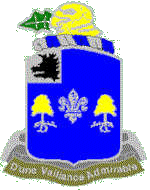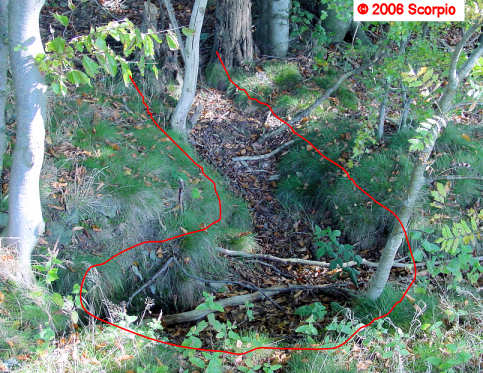39th Infantry Regiment (9th Inf. Div.)
13 Sept - 26 Oct 1944


22 September 1944
In the morning, K Company planned to continue its attack to the east. However, it could not move far until it had reduced the pillbox on its right flank. While I Company moved one platoon from the vicinity of Hill 554 east to the rear of K Company, part of K continued a slow advance down the road, while the rest worked to reduce the pillbox. At first 75 lbs of TNT were exploded inside the first door; that had little effect. White phosphorus grenades were dropped down the ventilators, with equal lack of success. Five gallons of gasoline were poured down the ventilator and set on fire. This brought no response, as did oily rags set afire and stuffed down the ventilator. Two teller mines from a captured supply were set off on top of the pillbox, but they only blew the ventilator off. Then about ten teller mines ( each containing 13 lbs of TNT ) were piled up on the pillbox in the hole in the ground made by the other two; these were exploded without perceptible result. Then 24 mines in one bunch were blown up without success. Finally a tank-dozer was brought up through a lane swept of mines to work in the night. Tanks could not be brought up in the daytime, since the enemy had excellent observation on the area. The engineers took about 400 lbs of TNT and two beehives and put them in the hole in the ground blown by the other explosions. They then packed down dirt all around it. When this was touched off the explosion was tremendous, and the enemy surrendered. An officer in the pillbox had prevented the soldiers from surrendering earlier. The entire day had been taken up with the reduction of this pillbox.
23 September 1944
The 2nd Battalion was supposed to move east towards Rollesbroich, but as it received counterattacks from the north, it could not proceed. The 3rd Battalion therefore held in this same general position.
24 to 28 September 1944
Throughout these days the entire battalion held defensive positions. One platoon of K Company took over part of the area in the zone where E Company had been holding, but otherwise there was little change.

Foxhole near PAK Garage #241 on Hill 554
29 September 1944
While the battalion had been holding its position and engaging in patrolling, plans had been perfected for an attack on Hill 554, L Company, which was on the right of the zone of action, was to attack east from Paustenbach, with the limited mission of taking the pillbox on the crest of the hill. Its attack, however, was dependant (in the planning) upon the actions of the other two companies. I Company was to swing around the open ground on the eastern slope of the hill, in order to come in on the enemy held portion from the southeast. K Company was to attack from the north, forming the left flank of the battalion zone of action, with the mission of securing the southeast part of the hill and protect the rest of the battalion from attack from that direction. A platoon of tanks were to go with the leading elements of the attacking force around the eastern slope of the hill.
The tanks led the assault. They came through the Dragons Teeth at the gap on the northwest part of the hill (976256), and swung around on the bare slope. They came in under a smoke screen at about 1000, since the attack had been held up a half-hour after the original jumping off time in order to get a proper smoke screen. The tanks moved much faster than the infantry, and they shot up the pillboxes and the enemy entrenchments with considerable success. Heavy enemy artillery fire hit, them when they reached the southeastern slope of the hill, but even though one tank was knocked out the rest stayed there to fire on the enemy.
The progress of K Company from the vicinity of 977262 south along a trail was rapid. It met moderate small arms opposition until it reached the pillbox (982253} on the southeast slope, where it came under heavy fire from the enemy towards Witzerath and Simmerath. K company therefore built up a position on the southeast slope of the hill (983254), where it could face the enemy farther to the east.
I Company reached the position it had held for a short time on 20 September, where the enemy met the advance with stiff small arms fire. I Company was therefore held up at this position on the hill, and along with the tanks took casualties from the artillery laid town in the area. At 1500, I Company reorganized and attacked again, this time to take the pillboxes on the southern slope of the hill. It took the area down to the pillbox at (977250), having secured the surrender of the two pillboxes in the vicinity of (976253). I Company then sent a patrol in the evening to the pillbox at (977250), and finding it unoccupied took possession of it. Also, it contacted by means of patrols elements of K Company on the left. In the second attack, as in the first, the companies secured good artillery preparations.
The attack as scheduled by L Company in the morning was originally contingent upon the success of I and K companies. However, when L Company moved back into position after the bombing and artillery preparations, they could observe no opposition from the enemy in the vicinity of their objective (the crest of the hill and pillbox 975254). On the spur of the moment; therefore, L Company attached at once and seized the objective before the enemy could recover sufficiently to offer a determined resistance. Until late in the afternoon L Company held the crest of the hill, in the evening it sent a patrol to pillbox (974250), which took it. By night, therefore, the 3rd Battalion had all of the area except CR974248 north of Bikerath.
30 September 1944
During the day the 3rd battalion made little essential change in its positions. It ran patrols and improved its defense. At 2000, however, the enemy launched a strong counterattack.
It drove from the south in between I Company and L Company, and in the darkness penetrated some distance into L Company's position. The pillbox 977250 was considered lost, when the enemy surrounded it, although actually there were elements of L company inside who stayed there until it was retaken. The enemy attack was definitely stopped by 0100, although it took time to clean out the small groups which had infiltrated into the position. However the moon came out, and in its light L Company attacked and by 0400 had taken the pillbox back. The enemy which had been behind the lines were either captured or escaped to the east.
1 October 1944
During the day K Company, which had withdrawn under the enemy attack re-occupied its former position and took 15 or more prisoners in the action. There were too many pillboxes in the area for the 3rd battalion to hold satisfactorily, so beginning in the afternoon the battalion shortened its lines. L and I companies withdrew from the pillboxes towards the bottom of the hill on the south, and I pulled in to a position nearer the crest of the slope on the southeast. This withdrawal was done in coordination with the activities of the engineers, who under the cover of darkness began to blow up the pillboxes which were being vacated. The engineers used six boxes of TNT, 50 lbs each. In the dark, however, one can of C rations got mixed in with one set of six boxes, so one pillbox was blown with five boxes of explosives and one box of rations -- while I Company found the next morning that it was issued for breakfast a box of TNT.
2 to 5 October 1944
The battalion remained on the defensive until it was alerted to move north to take part in a drive in the vicinity of Germeter and Vossenack.

